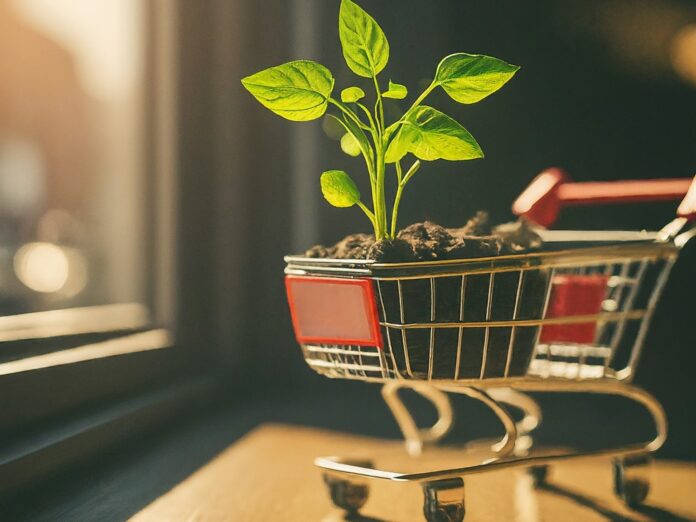
By Derek Rickard, Director of Sales, Cimcorp
Key Takeaways:
- Automation in grocery distribution centers supports sustainability through improved energy efficiency, particularly with gantry-style robots that use minimal energy and incorporate regenerative braking technology.
- Automated systems help maximize product shelf life by accelerating distribution, minimize disposable packaging through the use of reusable plastic crates, and reduce carbon emissions by optimizing truck loading and route planning.
- Modular automation solutions allow grocery retailers to grow their business and increase capacity within existing facilities, reducing the need for new construction and conserving resources.
In grocery retail, sustainability efforts are good for the environment, good for customers, and good for a business’s bottom line. Given these benefits, innovative grocery retailers are exploring better ways to implement sustainable practices across their supply chains. Distribution is one important area where they’re making big strides, thanks to automation. By leveraging automated order fulfillment technology within their distribution facilities, grocery retailers can improve sustainability in multiple ways.
1. Improving energy efficiency
Today’s automated storage and order picking systems offer low energy consumption — particularly solutions that utilize gantry-style robots to access and handle products from overhead. Gantry solutions made from lightweight, durable, and fully-recyclable aluminum require minimal energy usage. They allow for swift movement and acceleration, optimizing handling capacity within the DC. Every movement of the robots is precisely controlled by intelligent software for optimal energy efficiency.
On top of that, gantry-based order fulfillment systems incorporate regenerative braking technology, allowing them to recover braking energy and feed it back into the power grid. This capability significantly enhances their energy efficiency, since approximately 30% of energy gets gathered and reused.
2. Maximizing shelf life
The U.S. Department of Agriculture estimates that 30-40% of the food supply in the United States ends up as waste. All that food piles up in landfills, where it rots and produces massive amounts of greenhouse gasses that contribute to climate change. One big contributor to this problem is the premature spoilage of fresh produce and perishable foods. The longer it takes for fresh and perishable products to travel through the supply chain, the higher the chances of spoilage and waste.
Today, grocery retailers can take advantage of automation specifically designed to accelerate distribution for perishable products, like fresh produce, baked goods, and dairy products. These solutions combine buffer storage and order picking into one fast, seamless system. Fresh products can enter the facility and be picked immediately, enabling very short lead times. Products reach store shelves faster than ever before, minimizing the change of spoilage and maximizing shelf life. Shoppers then get their pick of optimally fresh food that lasts longer in their homes.
3. Minimizing disposable packaging materials
In the United States, grocery supply chains typically rely on cardboard boxes to transport fresh produce from the farm to the store shelf. While cardboard containers are relatively inexpensive up front, they don’t last very long. Plus, they are not stable or secure when stacked during storage, order fulfillment, and shipping processes. To reduce the need for disposable packaging materials, some grocery retailers have shifted to housing products in reusable plastic crates (RPCs). RPCs are highly durable and have a very long lifecycle. They can be re-used thousands of times, protecting products as they move from field to warehouse to store. After each journey, they can be easily sanitized and start all over again.
Automation can support this shift from cardboard to RPCs. Gantry-based automated order fulfillment systems are designed to match perfectly with RPCs. Overhead gantry robots can handle and securely stack the crates by SKU directly on the warehouse floor in high-density storage areas. Whenever a SKU is needed for an order, the gantry robots quickly and accurately pick the required crates from overhead.
4. Reducing carbon emissions
Behind the scenes in an automated DC, intelligent software controls everything from individual robot movements to the entire flow of products through the facility. This level of optimization plays a crucial role in not only boosting efficiency within the DC, but also reducing carbon emissions outside of it.
A Warehouse Control System (WCS) can build outbound orders to be route friendly. Then the software ensures pallets are loaded and organized efficiently within delivery trucks to support route optimization and make the most of available truck space. This level of optimization creates fuller trucks, so fewer trucks are needed on the roads. There are also fewer miles being driven, meaning less exhaust fumes and less pollution.
5. Growing with lower resource consumption
As a grocery business grows, DCs may struggle to house an ever-rising volume of products and serve a wider network of store locations. Many businesses see building an entirely new distribution facility as the only way to ease these growing pains. But new construction projects are very expensive, time consuming, and also expend significant resources, including land, building materials, and energy.
As a sustainable alternative, grocery retailers can retrofit their existing DCs with modular automation. Modular solutions are made up of individual blocks of automation that can be arranged to fit any existing facility footprint. The solutions can optimize storage space and maximize capacity, so that one existing DC can serve an increasingly larger network size. Grocery retailers can grow their business, without having to expend resources on building a whole new distribution facility.
Moving towards a greener future
In the grocery industry, automation is revolutionizing the way DCs operate, creating efficiencies that align with the growing need for environmental responsibility. By harnessing advanced robotics and intelligent software designed with sustainability in mind, grocery businesses can get more out of less, achieve their sustainability goals, and support an overall greener food supply chain.
 Derek Rickard is sales manager for Cimcorp. He works closely with Cimcorp’s global customers to develop robotic order fulfillment systems designed to meet their warehousing needs. With over 25 years of supply chain experience, Rickard has worked on many of the first fully automated robotic picking systems in North America.
Derek Rickard is sales manager for Cimcorp. He works closely with Cimcorp’s global customers to develop robotic order fulfillment systems designed to meet their warehousing needs. With over 25 years of supply chain experience, Rickard has worked on many of the first fully automated robotic picking systems in North America.




![[Webinar] From Selection to Success: Navigating the Food & Beverage ERP Journey](https://foodindustryexecutive.com/wp-content/uploads/2025/03/ECI_From-Selection-to-Success-Navigating-the-Food-Beverage-ERP-Journey-218x150.png)



